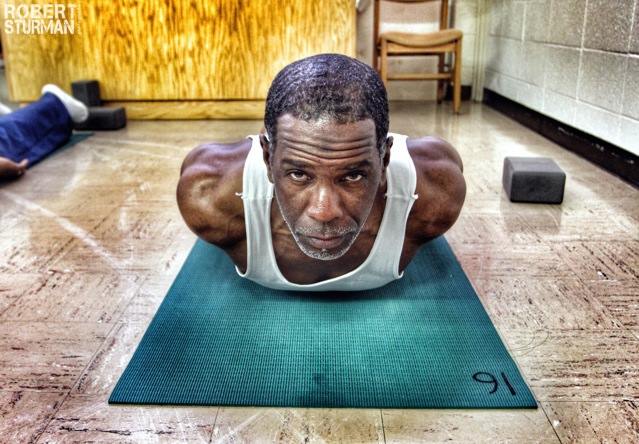
I am a teacher and ambassador for the Prison Yoga Project (PYP), a non-profit that expands the practice of hatha yoga and mindfulness meditation to prisons and rehabilitation facilities across the world under the leadership of James Fox. Below is a post James wrote explaining why we teach yoga and mindfulness in prison. For more information about PYP, please visit prisonyoga.org.
Most prisoners suffer from Complex Trauma, chronic interpersonal trauma experienced as children, such as abandonment, hunger, homelessness, domestic violence, sexual abuse, bullying, discrimination, drug and alcohol abuse, and witnessing crime – including murder and acts so horrifying they fit no category. We call this “original pain.” These experiences, imprinted by the terrifying emotions that accompany them, are held deeply in the mind, and perhaps more importantly, in the body, with the dissociative effects of impulsive/reactive behavior, and tendencies toward drug and alcohol addiction as well as violence. Carrying unresolved trauma into their lives impacts everything they do, often landing them in prison, where they experience even more trauma.
Traditionally, cognitive behavioral therapists have helped people process unresolved trauma, but more recently psychiatrists, psychologists, clinical social workers — many working with US military veterans — acknowledge that embodiment practices such as yoga enriched with mindfulness practices can have more impact in alleviating the symptoms that lead to both reactive behaviors and stress related disease. The Prison Yoga Project was founded in the belief that yoga, taught specifically as a mindfulness practice, is very effective in releasing deeply held, unresolved trauma, allowing us to address the resultant behavioral issues.
Yoga as a mindfulness practice is our tool for reengaging prisoners with their bodies to restore the connection between mind, heart and body. We use a trauma-informed yoga practice to develop the whole person, increase sensitivity toward oneself and empathy for others. By putting the men and women back in touch with their bodies, they begin to care more about themselves and understand the harm they have caused themselves.
The highest level of emotional intelligence or emotional literacy is sensate, getting past your mind and relying on your senses to tell you what’s going on in your body. Another way to put it is, using your body to teach your mind. We consistently teach a practice to provide prisoners with a skill to become aware of how they feel in their bodies. When you develop a close relationship with your own sensitivity, you are less apt to violate another. This is empathy. And empathy, when encouraged, leads to compassion. Gradually, the cycle of violence is interrupted.
Our objective is to provide prisoners with a mindfulness tool to draw on their yoga practice when they’re not doing yoga. If they’re tangled in a confrontation on the yard, or upon release, or tempted to go back to using, they can draw on what they have learned from yoga for practical solutions. They can do it without actually having to do a yoga pose to get the value. That’s the transformational, rehabilitative value of yoga.


